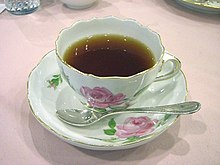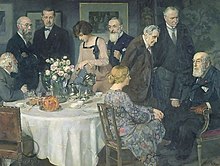Tea (meal): Difference between revisions
fix heading |
|||
| Line 31: | Line 31: | ||
[[Mrs Beeton|Isabella Beeton]] describes afternoon teas of various kinds: the old-fashioned tea, the at-home tea, the family tea and the high tea and provides menus.<ref>Beeton, Isabella (1901) ''Mrs Beeton's Cookery Book'', new ed. London: Ward, Lock; pp. 282-83.</ref> |
[[Mrs Beeton|Isabella Beeton]] describes afternoon teas of various kinds: the old-fashioned tea, the at-home tea, the family tea and the high tea and provides menus.<ref>Beeton, Isabella (1901) ''Mrs Beeton's Cookery Book'', new ed. London: Ward, Lock; pp. 282-83.</ref> |
||
===High tea=== |
|||
'''High tea''' (also known as '''meat tea'''<ref>April 23.—Mr. and Mrs. James (Miss Fullers that was) came to meat tea, and we left directly after for the Tank Theatre". ''[[The Diary of a Nobody]]''. George and Weedon Grossmith, with illustrations by Weedon Grossmith. 1892.</ref>) is an early evening meal, typically eaten between 5pm and 7pm. It is now largely followed by a lighter meal later in the evening. |
'''High tea''' (also known as '''meat tea'''<ref>April 23.—Mr. and Mrs. James (Miss Fullers that was) came to meat tea, and we left directly after for the Tank Theatre". ''[[The Diary of a Nobody]]''. George and Weedon Grossmith, with illustrations by Weedon Grossmith. 1892.</ref>) is an early evening meal, typically eaten between 5pm and 7pm. It is now largely followed by a lighter meal later in the evening. |
||
Revision as of 10:44, 4 November 2011
This article includes a list of general references, but it lacks sufficient corresponding inline citations. (November 2010) |
| Part of a series on |
| Meals |
|---|
 |
| Meals |
| Components and courses |
| Related concepts |
Tea can refer to any of several different meals or mealtimes, depending on a country's customs and its history of drinking tea. However, in those countries where the term's use is common, the influences are generally those of the former British Empire (now the Commonwealth of Nations). The tea meal can be small or large and used, for example in the phrase, "to take tea".
United Kingdom
Elevenses
Elevenses is a snack that is similar to afternoon tea, but eaten in the morning.[1] It is generally less savoury than brunch, and might consist of some cake or biscuits with a cup of coffee or tea.
Afternoon tea



Afternoon tea (traditionally known to Americans as low tea, a term unrecognised in Britain), is a light meal snack typically eaten between 2pm and 5pm. The custom of drinking tea originated in England when Catherine of Bragança married Charles II in 1661 and brought the practice of drinking tea in the afternoon with her from Portugal.[citation needed] Various places that belonged to the former British Empire also have such a meal. However, changes in social customs and working hours mean that most Britons will rarely take afternoon tea, if at all.[citation needed]
Traditionally, loose tea is brewed in a teapot and served in teacups with milk and sugar. This is accompanied by sandwiches (customarily cucumber, egg and cress, fish paste, ham, and smoked salmon), scones (with clotted cream and jam, see cream tea) and usually cakes and pastries (such as Battenberg, fruit cake or Victoria sponge). In hotels and tea shops the food is often served on a tiered stand; there may be no sandwiches, but bread or scones with butter or margarine and optional jam or other spread, or toast, muffins or crumpets.[2][3][4]
Nowadays, a formal afternoon tea is usually taken as a treat in a hotel or tea shop. In everyday life, many Britons take a much simpler refreshment consisting of tea and biscuits at teatime.[citation needed]
While living in Woburn Abbey, Anna Maria Russell, Duchess of Bedford, is credited as the first person to have transformed afternoon tea in England into a late-afternoon meal rather than a simple refreshment.[5]
Isabella Beeton describes afternoon teas of various kinds: the old-fashioned tea, the at-home tea, the family tea and the high tea and provides menus.[6]
High tea
High tea (also known as meat tea[7]) is an early evening meal, typically eaten between 5pm and 7pm. It is now largely followed by a lighter meal later in the evening.
High tea would usually consist of a hot dish such as fish and chips, shepherd's pie, or macaroni cheese, followed by cakes and bread, butter and jam. Occasionally there would be cold cuts of meat, such as ham salad. Traditionally high tea was eaten by middle to upper class children (whose parents would have a more formal dinner later) or by labourers, miners and the like when they came home from work. The term was first used around 1825 and high is used in the sense of well-advanced (like high noon, for example) to signify that it was taken later in the day [8].
In its origin, the term “high tea” was used as a way to distinguish it from afternoon tea. In America, there is a wide-spread misconception that afternoon tea is known as low tea in Britain; this is simply not the case. It is stated that the words 'low' and 'high' refer to the tables from which either meal was eaten. Afternoon tea was served in the garden where possible; otherwise it was usually taken in a day room, library or salon where low tables (like a coffee table) were placed near sofas or chairs generally (hence the fallacy about it being low tea). [9] Most quality hotels in Britain serve afternoon tea, frequently in a palm court, and more recently have offered the option of champagne instead of tea[10].
Other uses
In many parts of England, particularly the North of England and in many parts of Scotland, Wales and Northern Ireland, tea is used to mean the main evening meal.
Australia and New Zealand
Many Australians and New Zealanders call the early evening meal "tea", while others refer to it as "dinner", both terms are understood to refer to the same thing. Calling a meal "tea" reflects the custom of northern England, Wales, and Scotland where "tea" refers to an evening meal.
During the working day a "tea break" or just "tea" can refer to morning/afternoon tea (corresponding to elevenses or a coffee break) or a break in the afternoon. This may be taken in a designated tea room. Colloquially, a break of this sort may also be called a smoko, particularly by tradesmen and in the building industry.
United States


For most of the United States, the morning or afternoon break is not often referred to as tea as the beverage has not traditionally been a widespread choice with Americans. The term coffee break is used instead to denote a morning or afternoon break from work, or social gathering for a snack and short downtime, where hot and cold beverages and cakes, breads, and pastries are sometimes consumed.
The term "high tea" is also used in the United States to refer to afternoon tea or the "tea party," a very formal, ritualised gathering in which tea, thin sandwiches and little cakes are served on the best china. This usage is an analogical construction, the term "high" being associated with social formality (rather than a "high," or main, table).[citation needed]
This afternoon tea is increasingly served in high-end American hotels, and at a rising number of big-city teahouses, where it is sometimes described as "afternoon tea." The term "tea party" is still occasionally used in the U.S., either for a special occasion or in honor of a visiting celebrity or guest.[citation needed]
France, Belgium and Switzerland

Similarly, in French speaking Europe one finds "le goûter"[11][12] or "le quatre heures",[13] in other words, the 4:00 afternoon snack, often prepared for children who have returned from school hungry. There are many kinds, but generally this snack could be a baguette or roll with butter and jam or chocolate shavings or spread, or chocolate cookies, accompanied by hot chocolate, or orange juice, but never with tea or coffee (café au lait or milky tea are for breakfast, tea and coffee being considered as too exciting for children at the end of the daytime). Goûter for adults may consist of fruit syrups in water or sparkling water, and light biscuits (cookies) or pastries. Although it never really went away, the custom is now becoming very trendy in France as a nostalgic wave of baby boomers recall their childhood gastronomic pleasures.
The goûter, for children, is different from the tea party in France, or "thé" in French, which is a little formal party in the afternoon given at home for adult guests, usually between 5 o'clock and 7 o'clock. It consists of tea, juices, limonades, or syrups, pastries, petits fours, and biscuits or cakes. The cocktail party is only given after 7 o'clock, and includes alcohol, as the "thé" doesn't.
See also
References
- ^ Harper, Timothy (1997). Passport United Kingdom: Your Pocket Guide to British Business, Customs and Etiquette. World Trade Press. ISBN 1885073283.
- ^ Mason, Laura; Brown, Catherine (1999) From Bath Chaps to Bara Brith. Totnes: Prospect Books
- ^ Pettigrew, Jane (2004) Afternoon Tea. Andover: Jarrold.
- ^ Fitzgibbon, Theodora (1972) A Taste of England: the West Country. London: J. M. Dent.
- ^ [1]
- ^ Beeton, Isabella (1901) Mrs Beeton's Cookery Book, new ed. London: Ward, Lock; pp. 282-83.
- ^ April 23.—Mr. and Mrs. James (Miss Fullers that was) came to meat tea, and we left directly after for the Tank Theatre". The Diary of a Nobody. George and Weedon Grossmith, with illustrations by Weedon Grossmith. 1892.
- ^ Oxford English Dictionary 2nd Edition
- ^ "When the Queen came to tea", R Moody
- ^ Ritz Carlton web site
- ^ http://www.legouter.fr/
- ^ http://www.sergetheconcierge.com/2010/01/le-gouter-french-afternoon-snack-for-schoolkids-reinvented-by-grown-ups.html/
- ^ http://fr.wiktionary.org/wiki/quatre_heures
External links
- "Teas and Other Afternoon Parties", Chapter XIII of Emily Post's Etiquette (1922)
- SBS Food story on high tea: http://www.sbs.com.au/food/article/4277/Featured_Foodie_Michelle_Milton
- Wikibooks Cookbook
